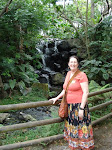On the Thursday before spring break, I asked the students in my class to bring an artifact (or picture or description of one) to class, something concrete or abstract that has come to mean something special for them. The ”collection” was pretty amazing, so I wanted to share them with you.
All of them were symbols of “how do I live” artifacts—how people and themselves are living in Costa Rica. Most students discussed objects: a chorreador (a simple drip coffee maker, used by everyone here), a collection of rocks and crystals in a Tico home and a newspaper clip of the student’s Tico dad in younger days as a track champion, ceramic shapes collected by a student’s Tica mom and similar to a collection she and her mom collect in the States, a picture of a student’s Tico family, stone spheres of mysterious origins found all over the country and in a story the class read , the wall of a Tica sister’s bedroom which is covered by phrases and drawings by friends, and the gallo (rooster), which decorates another Tico home and is a prominent sight (and sound) in C.R.
One student brought a bracelet that she wears to remind her her of a particularly memorable time while traveling, while others opted to bring food: a prickly green guanabana fruit that makes particularly tasty milkshake-like drinks ; salsa picante, a spicy sauce that no Tico kitchen would be without; and a coffee bean, symbolic of the heritage of Costa Rica, one of the main export crops, and the drink of choice here.
Lastly, two students chose to look at linguistic artifacts, both of which have significant meaning to visitors and natives alike: pura vida (literally pure life), used in response to “How’re you doing?” or How’s everything going,” to indicate “thank you ,” “ I’m doing well,” or simply as a tag line to be polite. The other word we hear often is gringo/a, and in Costa Rica simply refers to anyone from the US, Canada, or Northern Europe and not in a negative way as in some other Hispanic countries. The origin of the word is not clear, but there are some colorful stories.
I especially enjoyed the responses to this assignment at the mid-term point of the semester because it shows how well the class is noticing and reflecting on important features of this new culture. As we enter the second half of the semester, we are studying many areas of sustainability, looking forward to our mandatory visa trip to Nicaragua, and presentations of their semester-long projects. They look very promising, too, so we’ll talk about these later on the blog. And I’m sure there will be some interesting stories of Spring Break adventures, so stay tuned!
Tuesday, March 31, 2009
Subscribe to:
Post Comments (Atom)

























No comments:
Post a Comment